November / December 2018
Sydney
Coming from Tonga, I enjoyed this magnificent view of the harbor with the harbor bridge in the middle and the opera house on the lower left shortly before landing in Sydney.
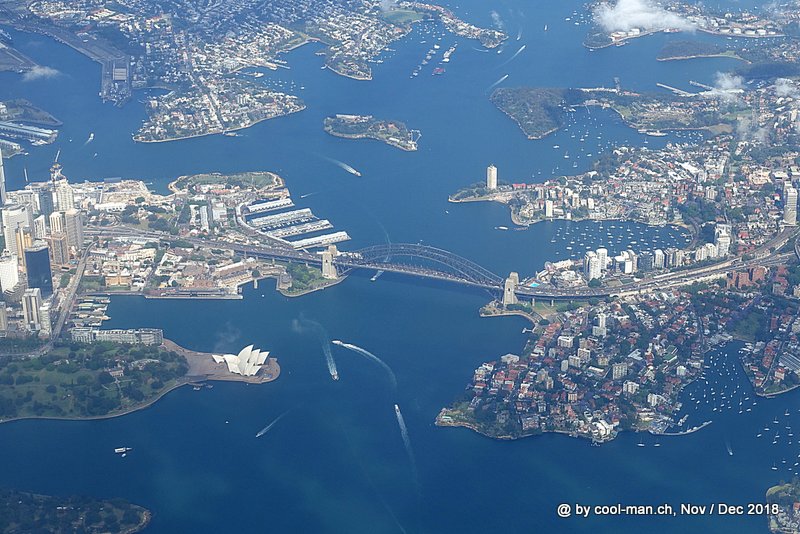
I liked the area around the harbor best during my stay in 2012. Unfortunately, all hotels around Circular Quai were expensive in November, so I stayed at Sydney Harbour The Rocks Youth Hostel in a 4-bed room. That was a good choice. On the one hand you could see the harbor and the opera house from the roof terrace of the hostel. On the other hand I shared my room with interesting people: A male software developer from California and a female photographer from Shanghai. On my last evening we ate together in a very recommendable steakhouse and discussed the different cultures.
The opera house and the ferries are simply photogenic.
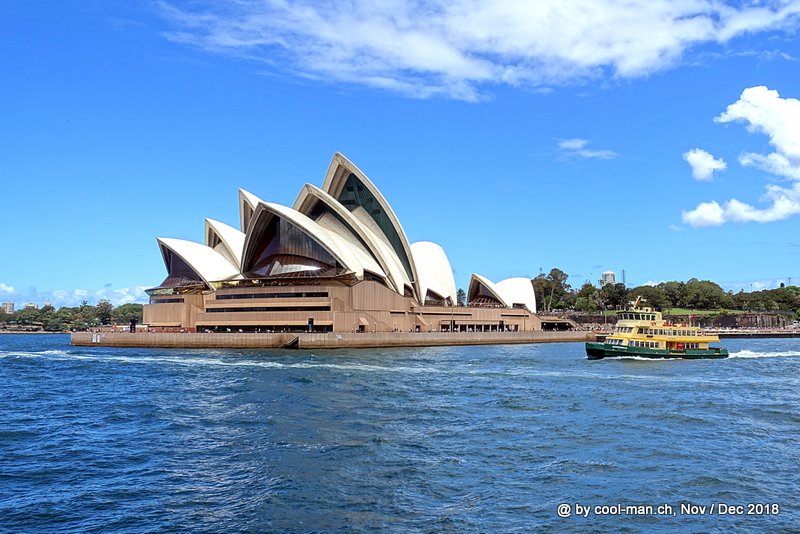
During my 3-week stay in Sydney in February/March 2012 I already took great photos, so this time I enjoyed the unique atmosphere of Sydney without having the camera always ready to hand.
Sydney offers countless museums. A particularly interesting one was the White Rabbit Museum, which shows contemporary Chinese art.

After a few days in Sydney I took my rental car and drove 250 km to the wine region Hunter Valley.
Southern Budgewoi Beach
On my way north I passed Southern Budgewoi Beach. It is a lonely beach with high waves and therefore not suitable for swimming. On my journey along the Australian coast I met these wild beaches again and again.
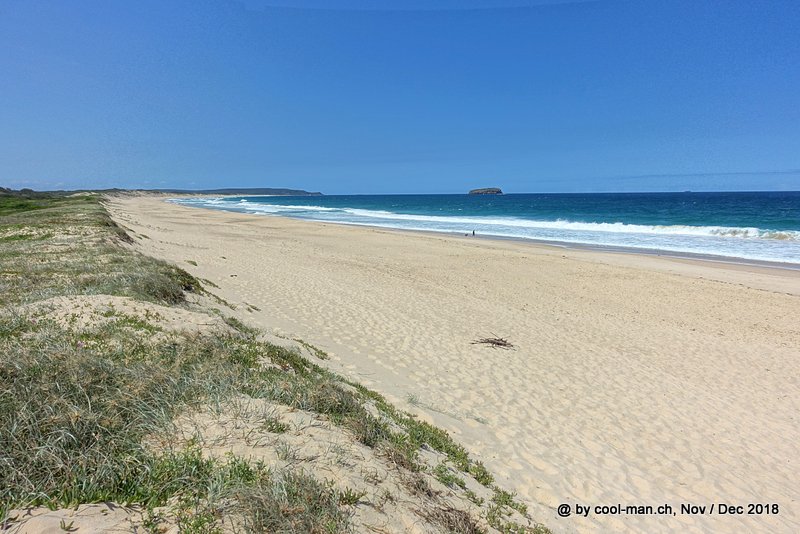
Hunter Valley
The Hunter Valley wine region has 120 wineries and a few gourmet restaurants. The most famous and best restaurant is the Muse, whose visit I describe on this page.
During four days I visited the wineries Peterson Wine, Gartelmann, Bimbadgen, Thomas Wines, Leogate, Brokenwood, Tyrell, Tempus Two, Audrey Wilson, Tulloch and Peppertree.
Some excellent sweet wines are produced in this area. Bimbadgen’s Moscato Sweet Rosé was simply perfect. I also liked the 2017 Brokenback Late Harvest Semillon from Leogate, the 2016 Sticky Wicket Semillon from Brokenwood and the Semillon 2017 dessert from Audrey Wilkinson.
The area is known for excellent white wines from the Semillon grape. My favorite wine in this category was the 2018 OC Semillon by Thomas Wines. Also the 2017 Benjamin Semillon from Gartelmann was very nice. The 2017 Special Release Gewurztraminer by Tyrrell’s is an excellent wine, too.
The Hunter Valley produces fine red wines as well. I loved the tannic wine 2016 Shiraz Limited Release from Peppertree Wines. Also the wines 2015 ‘Wilhelm’ Shiraz and 2015 ‘Diedrich’ Shiraz by Gartelmann, the wines 2016 Dam Block Shiraz and 2016 Elenay Shiraz by Thomas Wines, the wines 2016 Hunter Valley Shiraz and 2016 Lunatiq Heathcote Shiraz by Tyrrell’s and a 2017 Barbera by Tulloch brought joy.
Some wineries produce port wine like wines, which they call Tawny or Fortified wines. The Fortified Verdelho from Bimbadgen and the Fortified Creme de Vin from Tulloch remain in my memory.
The Bimbadgen winery produces the excellent sweet wine Moscato Sweet Rosé.

Canberra
Afterwards I drove to the capital Canberra which is more than 500 km away. Here the temperatures were unusually low with 10-15 degrees Celsius. Canberra was chosen in 1908 as a compromise location between the two cities Sydney and Melbourne and is with 410’000 inhabitants the biggest city of Australia in the interior. It is a spacious green city with a lake, Lake Burley Griffin. There are many institutions of national importance such as the Australian War Memorial, the Australian National University, the Royal Australian Mint, the Australian Institute of Sports, the National Gallery, the National Museum and the National Library. There is so much to see in each of these places, that there is often not enough time to look at everything in detail.
Australian War Memorial
Especially impressive was the Australian War Memorial, which is dedicated to the Australian soldiers who died in wars.
The Dome of the Australian War Memorial

A wall contains the names of all fallen soldiers. 62,000 hand-made poppy blossoms adorn the wall, as at the end of the First World War the red poppy was one of the first plants to bloom on the devastated battlefields of northern France and Belgium.

In the underground of the Australian War Memorial there is an excellent museum, which explains in detail all combat operations of the Australian Army. As part of the British Empire, Australian soldiers fought in every war in which Britain was involved. From Australia’s independence in 1901 these were World War I and World War II, but also many others such as the Vietnam War and the wars in Iraq and Afghanistan. The exhibition is so detailed that a whole day is not enough to study everything.
In addition, there are many exhibits such as this British Avro Lancaster bomber from the 2nd World War.

National Gallery of Australia
The National Gallery of Australia is one of the largest museums in Australia with over 166,000 exhibits. I spent many hours in this museum as well.
National Gallery of Australia: Fortunately these dogs don’t bite.

Royal Australian Mint
I also visited the Royal Australian Mint, where all Australian coins are minted. The first official Australian coins were minted in 1813 by William Henshall, who was convicted of counterfeiting before.
Coin production in the Royal Australian Mint

I also visited the new and old Parliament buildings. Since the politicians did not meet, the meeting rooms of the Senate and the House of Representatives could also be visited.
The National Museum of Australia is housed in a modern building and shows typical Australian themes like the gold rush or the history of the Australian car brand Holden.
The National Library showed an exhibition on Captain Cook’s travels.
Canberra is also a good place to eat.

Hyams Beach
After a few days in the capital I drove to the coast to Hyams Beach in Jervis Bay. This beach is famous for its extremely fine, almost floury sand.

Boderee National Park
This kangaroo showed up in the Boderee National Park near Hyams Beach.

The 700 km long route to 90 Mile Beach offers few sights. On the way I spent the night in Mollymook and visited a cheese dairy.
Unfortunately I saw more dead than living kangaroos on my trip. Especially at dusk and at night these animals become victims of road traffic.

Trinculo Wreck – 90 Mile Beach
The area around 90 Mile Beach was notorious among sailors for its many shallows, which were the fate of ships in storms. This is the wreck of the ship ‘Trinculo’, which stranded on a sandbank during a storm in 1879. The captain’s wife and their child were also on board. Fortunately the sandbank was only 15 meters away from the safe beach, so this accident did not claim any lives.
The wreck of the ship ‘Trinculo’, which sank in a storm in 1879
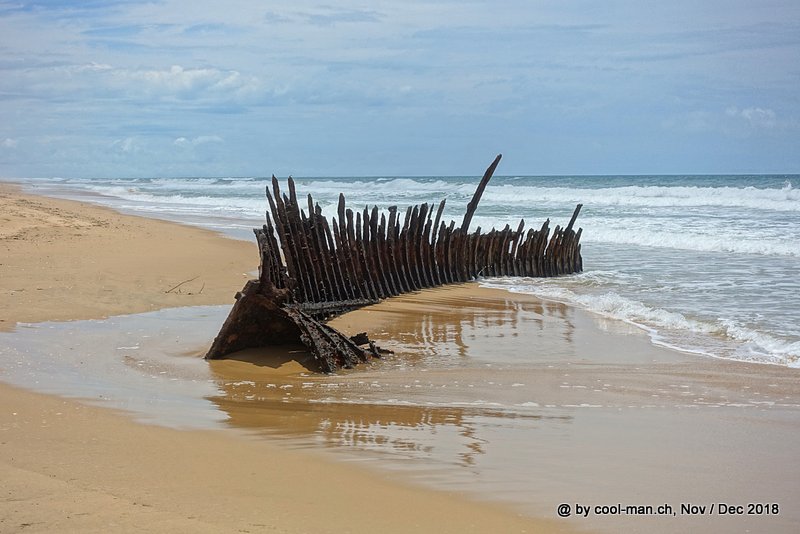
Wilsons Promontory National Park
I drove on to Wilsons Promontory National Park, which is the southernmost part of the Australian mainland. Only the island Tasmania is more southern. The visit of this park was one of the highlights of my trip to Australia. It offers spectacular landscapes with huge granite boulders, rain forests, wide beaches and great views.
The Tidal River is colored red by microorganisms.

On the way to Squeaky Beach




Swimming is not recommended on this beach.

Another hike led me to Mount Oberon. From the summit you can see the coastline and Squeaky Beach. Unfortunately the sky was overcast, so I don’t show any pictures here.
I love sand dunes and deserts. Also the Big Dig sand dunes offered the wind-generated waves in the sand.


Torquay – Australian National Surfing Museum
On my journey along the Australian coast I bypassed Melbourne and reached the city of Torquay, where the Great Ocean Road begins. One of the sights in this city is the Australian National Surfing Museum, which shows the history of surfing in Australia. The first boards were bought in Hawaii and brought to Australia. An exhibition part shows the development of the shape of the surfboards. Another shows videos of the most daring surf adventures. Injuries occurred again and again. The now worldwide known company Rip Curl was founded in 1969 in Torquay by two surfer friends. In order for them to be able to surf more, they quit their jobs and started to produce surfboards for themselves and their colleagues in a garage. Initially they produced four surfboards a week. Quicksilver, who started only a few years after Rip Curl, also comes from Torquay. One of the two founders was previously an employee at Rip Curl.
After a visit to Lorne, a small coastal town, I made a 90 km detour to have dinner at one of the best restaurants in Australia, the Brae, in the small town of Birregurra.
Split Point lighthouse
The next day I drove to the Split Point lighthouse from where there was a view over the cliffs.
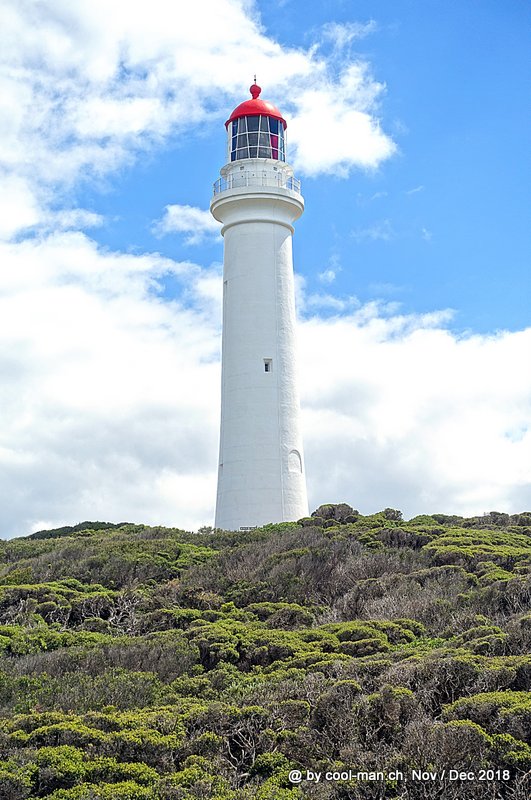
Teddy’s Lookout
Colorful birds can be seen at Teddy’s Lookout in the coastal town of Lorne.

Since there are mostly tourists on the Great Ocean Road and there is little traffic, the Australian police put up these signs. On the ground there were big arrows painted at the exit of the sights, which indicate the driving direction. Apparently tourists had already caused accidents because they were driving on the wrong side of the road. Some traffic signals were even written in Chinese.
Signs show the direction of travel in Australia.

Maits Rest
At Maits Rest, a 30-minute walk leads through an ancient rainforest protected by the Great Otway National Park.

12 Apostles
The most famous landmark of the Great Ocean Road are the so-called 12 Apostles, limestone rocks off the coast of Port Campbell National Park. After a rock collapsed in 2005, there are now eight rocks left. I first visited the 12 apostles before sunset.
The apostles from the vantage point to the north …

…and south.

The next morning I was at the 12 Apostles at 7 o’clock and therefore could enjoy them almost alone.
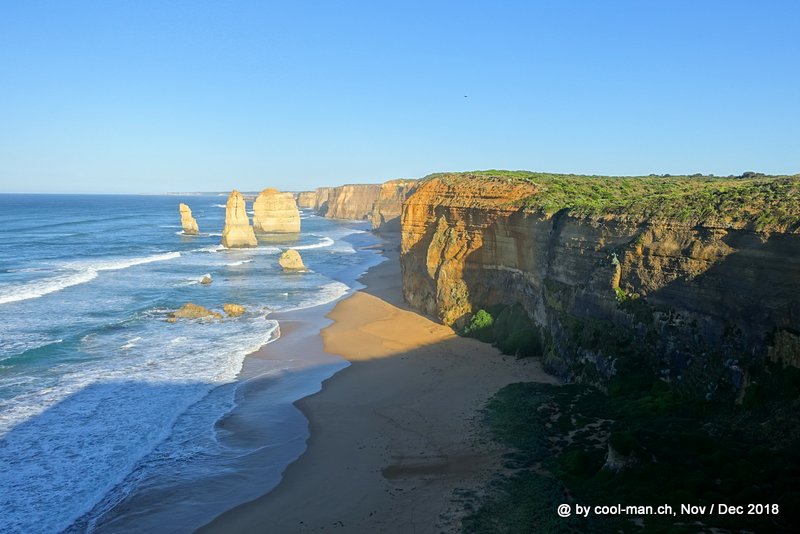


The cliffs

Loch Ard Gorge
The Loch Ard Gorge is named after the ship Loch Ard, which ran aground in 1878 shortly before the end of a three-month journey from England to Melbourne during a storm on a nearby island. Only two of the 45 passengers survived.

London Bridge
The rock formations known as the ‘London Brigde’

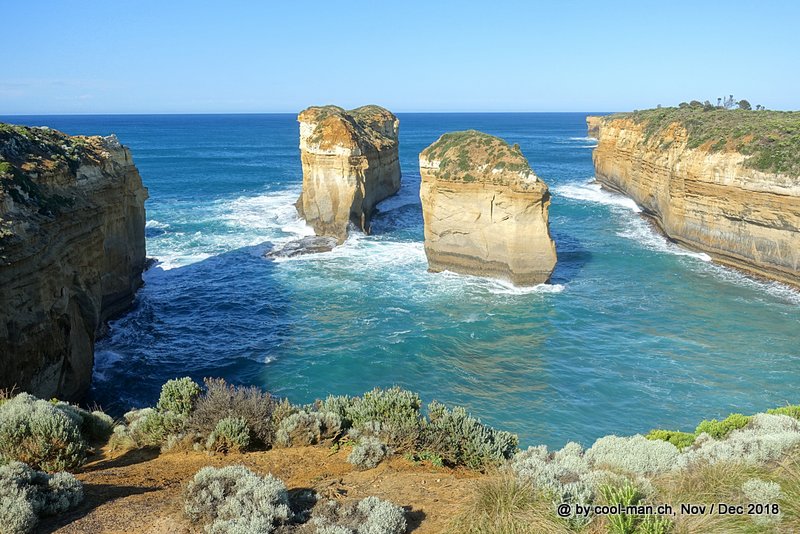
Coonawarra wine region
On the same day I drove 300 km to Coonawarra, another wine region. The wine region is small with 28 wineries. It is 300 km south of Barossa, so it is about 5 Celsius cooler, which affects the grapes. The Cabernet Sauvignon grape grows particularly well here.
I had dinner in the small restaurant ‘Pipers of Penola’, which earned several awards for its regional cuisine.
The next day was Sunday. Thus, some wineries opened later. Since I wanted to continue on the same day, I only visited two wineries: Wynn’s and Parker.
Samuel Wynn was the first to recognize the potential of this area in 1951 and bought a vineyard here. Today Wynn’s is an excellent producer. The sweet wine Late Harvest Riesling 2018 is brilliant, but also the Gables Cabernet Sauvignon 2016 was worth drinking.
At Parker I liked the 2017 Coonawarra Series Cabernet Sauvignon.
McLaren Vale wine region
On the same day I drove to McLaren Vale, 390 km away, south of Adelaide. It should become my favourite wine area. Here I visited during three days the wineries Oliver’s Taranga Vineyards, d’Arenberg, Coriole, SC Pannell, Gemtree, Hugh Hamilton, Penny’s Hill, Leconfield, Wirra Wirra and Serafino. The Mister Riggs winery recommended by a colleague was unfortunately closed. The quality of the wines was amazing. I hardly found any wineries that didn’t have at least one excellent wine in their assortment.
The inconspicuous winery Coriole produces an excellent 2016 Estate Grown Cabernet Sauvignon.

At the Hugh Hamilton winery there is a black sheep on the entrance stairs because he has always been the black sheep of the family. Today he celebrates this status. So he founded a ‘Black Sheep Club’ and calls his wines ‘Agent Provocateur’ or ‘Drama Queen’. I especially liked the wines ‘The Mongrel’, a 2017 Sangiovese Blend and the Muskat Liqueur ‘The Ruffian’.

But a class of its own was the winery d’Arenberg, which is run in the 4th generation by the Osborne family. Every wine tour makes a stop here.
The idiosyncratic building is based on a twisted cube. The building should reflect the complexity and the mysterious interrelations of winemaking.

The entrance leads into a 360-degree video installation that tells the story of Mclaren Vale, the winery and the thoughts of the Osborne family. But it’s also the joy of the technical possibilities that makes this well-done show so special.


The tasting room is located on the top floor of the building. I liked the 2015 d’Array’s Original Shiraz Grenache.
On my way to the Barossa Valley I stopped in the small town of Hahndorf. The city was founded in 1838 by Lutherans from Prussia and is Australia’s oldest preserved German settlement. Today the town thrives on tourism.
Hill Winery
Not far from the town is the Hill Winery, which offers wine tastings along with exquisite chocolate. In my opinion the wines and the chocolate did not really fit together. What was new to me, however, was the water that was served with the chocolate to neutralize the palate between tastings. Cape Grim water is said to be the purest water in the world. Cape Grim is located in the westernmost corner of Tasmania. The winds from Antarctica blow water vapor without any impurities to Tasmania, where the clouds rain down on the cliffs of Cape Grim. Only when the air over Cape Grim is completely clean is the rainwater collected and bottled.
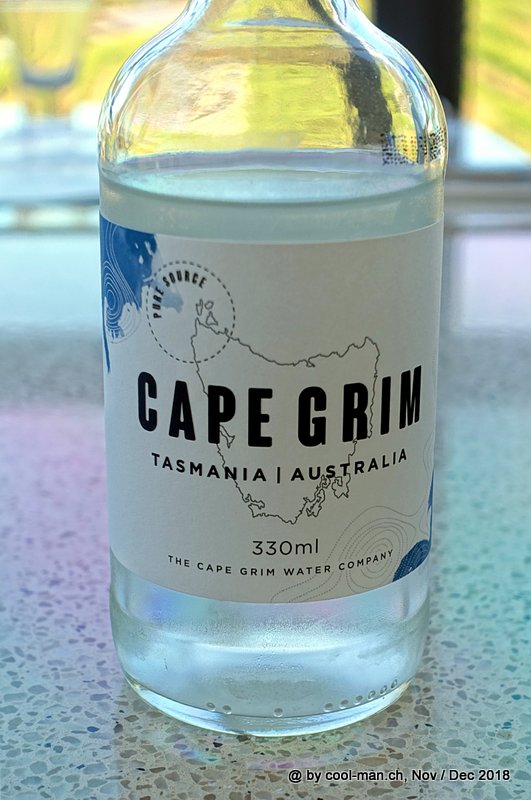
Barossa Valley wine region
Afterwards I drove to the Barossa valley 70 km away. At the beginning of the 19th century it was settled by Lutherans persecuted in Prussia. Seven generations have made the Barossa Valley with its 150 wineries one of the largest wine regions in Australia. In summer it gets hot up to 50 degree Celsius. Not all grape varieties can tolerate these temperatures equally well, so that the Barossa Valley is known above all for its Shiraz wines. Many wineries buy grapes from the cooler Coonawarra wine region to round off their assortment.
During three days I visited the following wineries: Elderton, Yalumba, Lambert, Henschke, Two Hands, Seppelsfield, Flat Turkey, Lehman Winery, Chateau Tanunda, Rockford and Saint Hugo. I also visited Artisan de Brarossa. This is a tasting platform shared by six boutique wineries.
At Elderton Wines I liked the 2018 Barossa Semillon and the 2018 Barossa Rosé. The 2016 Golden Semillon sweet wine was not so intense, but its lightness made it exceptional.
The red wines at Yalumba were nothing special, but the sweet wine FSW8B Botrytis Viognier 2017 was fantastic and just as good as the Moscato Sweet Rosé from Bimbadgen in the Hunter Valley. Also the Antique Tawny NV convinced me.
The tasting room at the Yalumba Winery

At Henschke I liked the 2016 Noble Gewürztraminer Botrytis, although I hardly noticed the typical taste of the Botrytis fungus.
All wines of the boutique winery Two Hands were excellent. Accordingly, the cheapest bottle cost AUD 45.
Seppelsfield is a large winery with a restaurant that is visited by many tourist buses. The wines did not convince me.
In Flat Turkey, a Swiss woman who is married to a local has served the wines. She was happy to speak Swiss German again and told me a lot about life in the Barossa Valley and about the different wineries. For example, she told me that in Australia the cultivation and harvesting of the vines (growing) is mostly separated from the wine production (wine making). It is common for wine makers to buy grapes from different grape growers. The two parties often work together for many years to ensure the quality of the grapes. I have not known this separation of the two tasks until now. In Europe, it is common for grapes to come from one’s own vineyard.
The Turkey Flat estate owns Shiraz vines from 1847. There is no other place in the world where such old vines can be found due to the phylloxera crisis at the end of the 19th century in Europe. The wine ‘The Ancestor’ produced from these vines was of course not for tasting.
The Lehmann Winery developed out of a project that enabled the grape producers to sell their grapes in the surplus years 1977 and 1978. Even today, the estate buys almost all its grapes externally. The Barossan Shiraz 2016 was worth drinking.
Chateau Tanunda is the largest and oldest wine chateau in Australia. It was built in 1880 in response to the decimation of European vineyards by the phylloxera plague and was the largest winery in the southern hemisphere. I visited the Chateau on a warm day. Unfortunately, all the wines served were too warm, so I didn’t like them.
Six boutique wineries together run the tasting platform ‘Artisans of Barossa’. All the wines served were of excellent quality. I especially liked the 2014 Selene Tempranillo from Sons of Eden and the 2017 Meta Shiraz from Schwarz Wines. The best red wine of my trip to Australia was the 2016 Shiraz by Hobbs of Barossa. I have never experienced Shiraz so intensively! Unfortunately the bottle costs AUD 160 (USD 115).
The 2016 Rifle Range Cabernet Sauvignon from Rockford Winery tasted good to me.
In the Saint Hugo winery there is style.


I really liked the 2016 Barossa Shiraz and the 2015 Cabernet Sauvignon/Shiraz with a light mint taste at St Hugo. As so often, the Cabernet Sauvignon grapes come from Coonawarra and the Shiraz grapes from the Barossa Valley.
A change to the wine offered the tasting of the cheese factory in Angaston, whose cheeses were almost as good as those from Switzerland. 😉
From the Barossa Valley I drove to Adelaide Airport, returned the car and flew to Melbourne, my last stop on this Australian trip.
Melbourne
Melbourne is a city with a high quality of life. Although Sydney is more famous abroad, the people of Melbourne are happy that they do not have to live in Sydney. Price levels in Sydney are higher, people are less friendly, public transport is worse and there are fewer cycle routes than in Melbourne.
A floating bar on the Yarra River

Rowing on the Yarra River

The Queen Victoria Garden

Carlton Garden
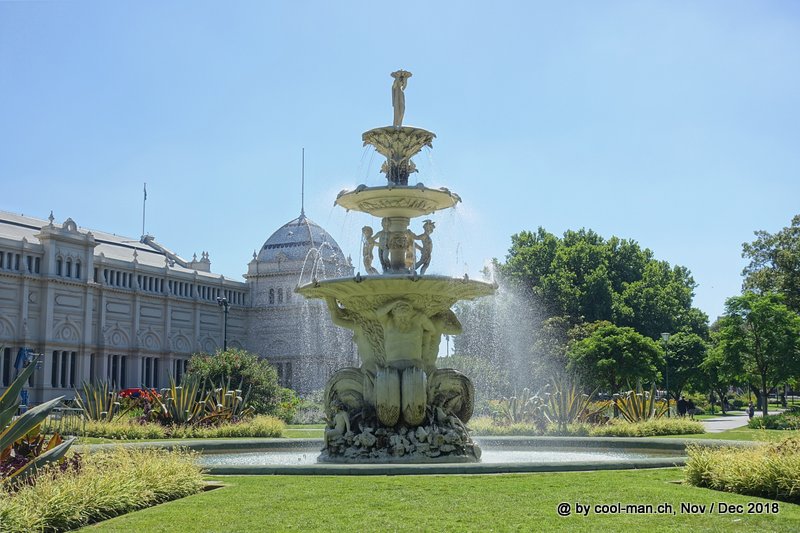
I visited countless sights in Melbourne.
The National Gallery of Victoria showed interesting exhibitions about the work of M. C. Escher and Julian Opie.
The Ian Potter Centre specializes in Australian art.
Eureka Skydeck 88 is a viewing platform on the 88th floor of a high-rise building.
The Shrine of Remembrance honors the fallen soldiers.
Founded in 1854 as the Melbourne Public Library, the State Library of Victoria is Australia’s oldest public library. It holds over two million books and 350,000 photographs, manuscripts, maps and newspapers.

The Old Melbourne Goal is an excellent museum about Melbourne’s first prison, which was in operation between 1842 and 1924. I spent hours reading the fates of many inmates. Homelessness was already a reason for imprisonment, which was especially fatal for women when they were abandoned by their husbands and had to give their possessions to the man. The most famous prisoner was Ned Kelly, a kind of Australian Robin Hood who killed several police officers and was hanged in 1880. He still lives on in songs, books and films. I was particularly touched by the story of the bar operator Colin Campbell Ross, who was accused of raping and murdering a 12-year-old girl. The main evidence was hair found in his house that allegedly matched that of the victim. Although he claimed his innocence, he was hanged in 1921. Later, the hair found was analyzed using DNA techniques and it was determined that it did not belong to the victim. In 2008, Colin Campbell Ross was posthumously pardoned.
With the iron switch in front of the door in the picture below the trap door was opened, whereupon the condemned fell with the rope around his throat into the opening and broke his neck under his own weight. Hanging needed a lot of experience, because the goal was a short, painless death, which did not always happen. Depending on the weight of the prisoner , the fall height and thus the length of the rope had to be adjusted. In case of a too short fall the strength on the neck was too weak and the convict died slowly with full consciousness. If the rope was too long, the fall led to an unwanted beheading. There were even tables for this. 135 people were hanged at this place.

In Saint Paul’s Cathedral I was impressed by the efficient way of donating. Just tap with the credit card and AUD 5 will be debited.

The end of a wedding

Checking Facebook during the break.

Night scenes



In Melbourne I met a friend of many years whom I know from a boat tour in Indonesia. He led me to an innovative Greek restaurant and kindly allowed me to have Samsonite send a warranty replacement suitcase to his address.
During my trip I drank Cafe Latte and often got a coffee with nice decorations.


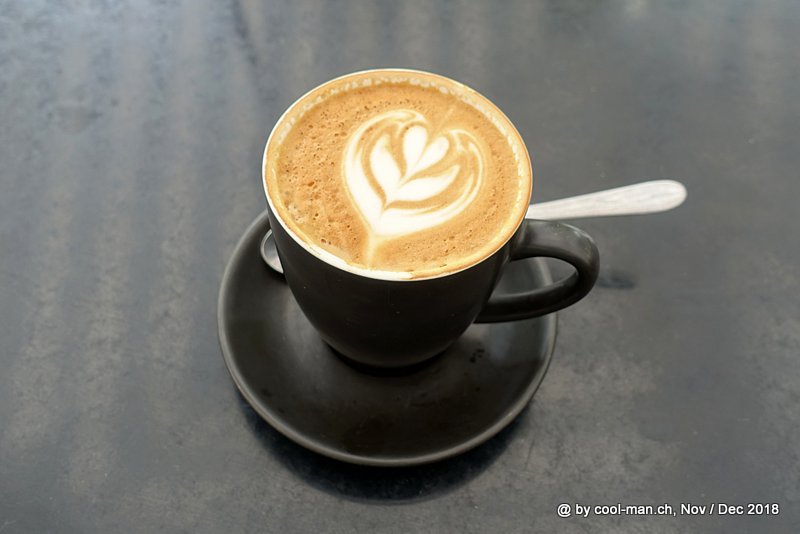


After four eventful weeks in Australia I flew to Thailand, where I visited more wineries.
This text is an automatic English translation from the German original by deepl.com